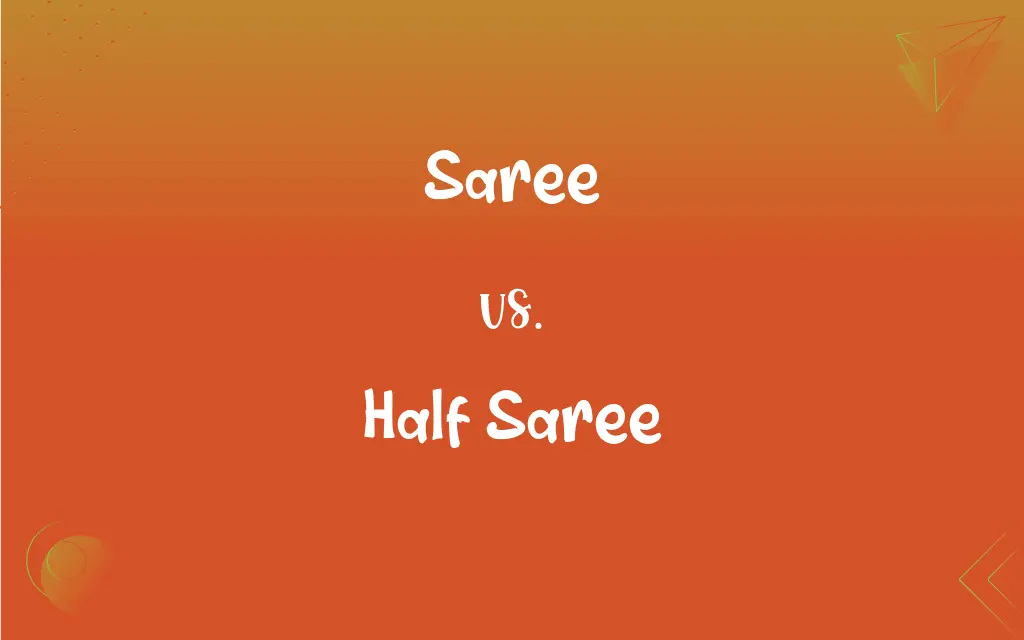Saree vs. Half Saree: What's the Difference?
By Janet White || Published on September 11, 2024
A saree is a traditional full-length garment, while a half saree is a two-piece outfit, both significant in South Asian culture.

Key Differences
A saree is a long piece of cloth, typically around 5 to 9 yards in length, wrapped elegantly around the body, with one end draped over the shoulder. It is worn over a petticoat (underskirt) and paired with a blouse, epitomizing traditional South Asian attire. The saree is versatile, worn for daily wear, work, festivals, and weddings, showcasing an array of fabrics, designs, and regional styles. Conversely, a half saree, also known as Langa Voni in some regions, is a traditional dress worn by young women in South India, signifying the transition from girlhood to womanhood. It consists of a skirt (Langa), a blouse (Choli), and a stole (Voni or Dupatta) that is draped over the blouse and skirt, similar in appearance to a saree but easier to wear and manage, making it suitable for younger women.
The saree symbolizes grace and cultural heritage, reflecting the wearer's regional identity through its material, weaving patterns, and draping style. From silk to cotton, and from heavily embroidered to plain, sarees serve as a canvas for showcasing craftsmanship. The half saree, on the other hand, is often vibrant and embellished, designed to celebrate youth and femininity. It's a rite of passage garment, commonly worn by teenage girls during festivals and special occasions.
The saree is recognized globally for its elegance and has been adopted in various forms beyond its traditional roots, the half saree remains closely tied to regional customs and traditions, particularly in South India. The half saree offers more freedom of movement and is considered a practical option for younger wearers, bridging the gap between childhood attire and the more formal saree.
Both the saree and half saree play significant roles in South Asian culture, representing different stages of a woman's life and reflecting the rich diversity of Indian traditions. The choice between a saree and a half saree often depends on the occasion, the wearer's age, and personal preference, with each garment holding its unique charm and significance.
Comparison Chart
Composition
Single piece of cloth, 5-9 yards
Skirt (Langa), Blouse (Choli), Stole (Voni/Dupatta)
ADVERTISEMENT
Worn by
Adult women
Young women and teenagers
Symbolism
Elegance, maturity, cultural heritage
Transition from girlhood to womanhood, youth
Occasions
Daily wear, festivals, weddings
Festivals, special occasions
Ease of Wearing
Requires practice to drape
Easier to wear, suitable for active wear
Saree and Half Saree Definitions
Saree
A traditional full-length garment.
She wore a silk saree to the wedding, showcasing exquisite craftsmanship.
ADVERTISEMENT
Half Saree
Consists of a skirt, blouse, and stole.
The stole of the half saree was draped elegantly, mimicking a saree's pallu.
Saree
Symbolizes elegance and cultural heritage.
The saree she chose for the festival represented her regional identity.
Half Saree
A two-piece traditional outfit for young women.
For her birthday, she wore a vibrant half saree, embracing her culture.
Saree
Reflects regional weaving patterns.
The Banarasi saree is renowned for its fine silk and elaborate designs.
Half Saree
Signifies the transition to womanhood.
The half saree ceremony is a celebrated rite of passage in South India.
Saree
Requires practice to drape correctly.
Mastering the art of draping a saree beautifully is a skill cherished by many.
Half Saree
Celebrates youth and femininity.
Her half saree was adorned with flowers and bright colors, reflecting youthful exuberance.
Saree
Versatile and worn for various occasions.
From cotton sarees for daily wear to embellished ones for special events.
Half Saree
Easier to wear and manage.
The half saree offers comfort and freedom of movement for younger girls.
Saree
Variant of sari.
Saree
The principal garment of a Hindoo woman. It consists of a long piece of cloth, which is wrapped round the middle of the body, a portion being arranged to hang down in front, and the remainder passed across the bosom over the left shoulder.
Saree
A dress worn primarily by Hindu women; consists of several yards of light material that is draped around the body
FAQs
What is the main difference between a saree and a half saree?
A saree is a single piece of cloth draped around the body, while a half saree is a two-piece outfit for younger women.
Who typically wears a half saree?
Half sarees are traditionally worn by young women and teenagers in South India.
How does the symbolism of a saree differ from that of a half saree?
A saree symbolizes elegance and cultural heritage, while a half saree represents the transition from girlhood to womanhood.
Is it easier to wear a saree or a half saree?
A half saree is generally considered easier to wear and more suitable for active wear, especially for younger individuals.
Can a half saree be worn for formal occasions?
Yes, half sarees are often worn for festivals and special occasions, adorned with elaborate designs and fabrics.
How has the saree evolved over time?
The saree has seen various adaptations in draping styles, fabrics, and designs, influenced by fashion trends and individual preferences.
Is there a particular age group that transitions from wearing a half saree to a saree?
The transition from half saree to saree typically occurs in late adolescence or early adulthood, although it varies depending on personal choice and regional customs.
Do both saree and half saree require specific accessories to complete the look?
Yes, both outfits are often accessorized with traditional jewelry, footwear, and sometimes a waist belt (kamarband) to enhance the attire's elegance and authenticity.
How do fabric choices affect the style and occasion for wearing sarees and half sarees?
The fabric choice significantly influences the outfit's suitability for various occasions; silk is preferred for formal events, while cotton and georgette are favored for daily wear or casual events.
Can the saree and half saree be found in fabrics other than silk?
Yes, both garments come in a variety of fabrics, including cotton, georgette, and chiffon, among others.
Are half sarees only worn in South India?
While primarily associated with South Indian culture, the popularity and recognition of half sarees have grown, and they are sometimes worn in other regions as part of cultural celebrations.
How do the occasions for wearing a saree compare to those for a half saree?
Sarees are worn across a broader spectrum of occasions, from daily wear to formal events, while half sarees are typically reserved for festivals and special occasions by younger women.
Can a half saree be considered a modern adaptation of the traditional saree?
While the half saree is a traditional outfit in its own right, its design and practicality offer a modern appeal, especially for younger wearers who may find it a more accessible introduction to traditional wear.
How have modern fashion trends influenced the designs of sarees and half sarees?
Modern fashion trends have introduced contemporary designs, patterns, and accessories into traditional saree and half saree attire, making them appealing to a broader, more fashion-forward audience.
What is the significance of the draping style in sarees and half sarees?
The draping style can signify regional identity, personal style, and the formality of the occasion, with specific drapes associated with different regions or communities.
How do sarees and half sarees reflect the cultural diversity of India?
These garments showcase India's cultural diversity through their regional variations, materials, designs, and the occasions they are worn, each telling a story of the area's heritage and traditions.
What is the significance of the half saree ceremony?
The half saree ceremony marks a girl's passage into womanhood, celebrated with gifts of half sarees among friends and family.
How does the regional variation affect the style of sarees and half sarees?
Regional variations influence the fabric, design, and draping style of sarees and half sarees, reflecting local culture and traditions, such as the difference between Kanjeevaram sarees from Tamil Nadu and Paithani sarees from Maharashtra.
What role does color play in the selection of sarees and half sarees for different occasions?
Color plays a significant role, with certain colors often chosen for specific occasions; for example, red is traditionally favored for weddings, while white and black may be avoided during festive occasions.
What future trends might influence the evolution of sarees and half sarees?
Future trends may include the fusion of traditional designs with contemporary fashion elements, eco-friendly materials, and digital technology in weaving and printing, reflecting evolving tastes and sustainability concerns.
About Author
Written by
Janet WhiteJanet White has been an esteemed writer and blogger for Difference Wiki. Holding a Master's degree in Science and Medical Journalism from the prestigious Boston University, she has consistently demonstrated her expertise and passion for her field. When she's not immersed in her work, Janet relishes her time exercising, delving into a good book, and cherishing moments with friends and family.






































































